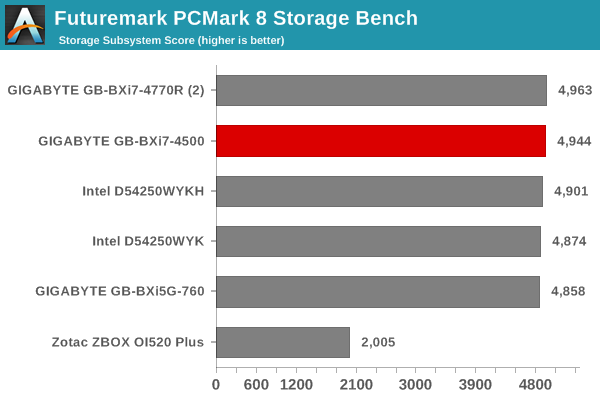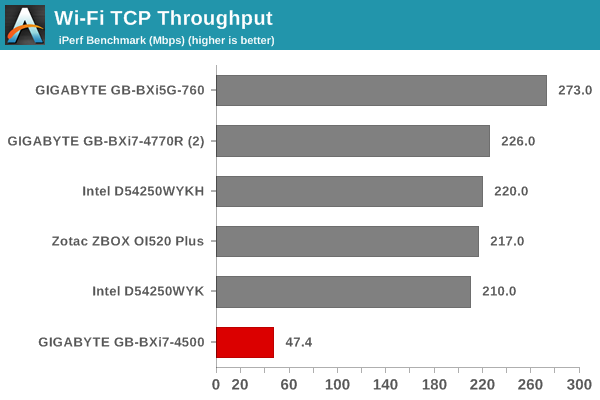GIGABYTE BRIX GB-BXi7-4500 Review: Intel Core i7 in a UCFF PC
by Ganesh T S on October 9, 2014 7:00 AM ESTNetworking & Storage Performance
We have recently started devoting a separate section to analyze the storage and networking credentials of the units under review. On the storage side, one option would be repetition of our strenuous SSD review tests on the drive(s) in the PC. Fortunately, to avoid that overkill, PCMark 8 has a storage bench where certain common workloads such as loading games and document processing are replayed on the target drive. Results are presented in two forms, one being a benchmark number and the other, a bandwidth figure. We ran the PCMark 8 storage bench on selected PCs and the results are presented below.


The Plextor PX-128M6M turns out to be the best-performing mSATA SSD that we have evaluated for UCFF systems. Even though the storage sub-system scores are quite close to each other for all the SSD-equipped machines, the storage bandwidth numbers show a clear lead for the PX-128M6M over the other mSATA SSDs. In terms of both parameters, only the Samsung SSD 840 EVO (2.5" version) scores a lead over the PX-128M6M. However, the current performance issues with reading of old data from the Samsung EVO drives may make users hesitate in purchasing a mSATA version of the same. In any case, the Plextor PX-128M6M currently retails for around $90 compared to the $105 for the Samsung 840 EVO 120 GB mSATA drive.
On the networking side, we restricted ourselves to the evaluation of the WLAN component. Our standard test router is the Netgear R7000 Nighthawk configured with both 2.4 GHz and 5 GHz networks. The router is placed approximately 20 ft. away, separated by a drywall (as in a typical US building). A wired client (Zotac ID89-Plus) is connected to the R7000 and serves as one endpoint for iPerf evaluation. The PC under test is made to connect to either the 5 GHz (preferred) or 2.4 GHz SSID and iPerf tests are conducted for both TCP and UDP transfers. It is ensured that the PC under test is the only wireless client for the Netgear R7000. We evaluate total throughput for up to 32 simultaneous TCP connections using iPerf and present the highest number in the graph below.

In the UDP case, we try to transfer data at the highest rate possible for which we get less than 1% packet loss.

In both tests, we are let down by the presence of a 1x1 802.11n mPCIe card. It connects only to the 2.4 GHz band and simply can't stand up to the other competitors which are 802.11ac-capable units. The GB-BXi7-4500U is still being sold with the Realtek RTL8723AE mPCIe card. Hopefully, future revisions will move to the RTL8821AE (1x1 802.11ac) that is being used in the BRIX Pro and BRIX Gaming units.










27 Comments
View All Comments
Shadowmaster625 - Thursday, October 9, 2014 - link
$750!!! haha. Pass it over here, man. May as well just buy a surface pro. Its not like this is a real i7 anyway. It is just an underclocked desktop i3 that occasionally runs at near stock clocks. And for that they charge $750!!!!Flunk - Thursday, October 9, 2014 - link
To get an equivalent processor in a Surface Pro 3 it would cost you $1,599.00, so I don't know what you're thinking of there.This is the same story as it always is with small form factor systems. You're paying for the size. The NUC form factor is small enough to attach to a VESA bracket. To get to that size they need to use Ultrabook components. If you want cheap pick up an AMD AM1 chip and mini-itx board or one of the little Baytrail Celeron-based mini-itx boards.
johnny_boy - Thursday, October 16, 2014 - link
You don't need ultrabook components for a vesa mountable pc. A number of mITX cases have them. And they use full sized components like ram and hardisks. The problem with todays mITX standard is that there is no appropriate small psu standard to match. SFX is till too big and pico psus require (always?) external bricks.dakishimesan - Thursday, October 9, 2014 - link
I love small ff pcs, but the mac mini is available for 599 with 2.5GHz dual-core Intel Core i5 (Turbo Boost up to 3.1GHz) with 3MB L3 cache, or 799 with 2.3GHz quad-core Intel Core i7 (Turbo Boost up to 3.3GHz) with 6MB L3 cache -- 35w cpus in a close size.WithoutWeakness - Thursday, October 9, 2014 - link
Mac Mini is considerably larger/heavier and can't be VESA mounted without dropping $50+ on an adapter. It certainly is a very capable machine for its size and the more powerful CPU options blow past the NUC-class devices but NUC, BRIX, and similar devices do a good job filling a niche for super-small "powerful-enough" x86 devices. I have the i5 Haswell NUC for a media center box and it's great for everything from media playback to some casual 1080p couch gaming and it's hardly bigger than my Raspberry Pi.MrCommunistGen - Thursday, October 9, 2014 - link
Also, despite the raw performance of the Mac Mini compared to dual core NUC-like devices, the Mac Mini uses IVB CPUs and come with 5400 RPM HDDs standard. I can see the former being an obstacle to some of the HTPC crowd. For the latter... I simply demand SSDs in any computer I spend any time using.dakishimesan - Thursday, October 9, 2014 - link
Yes true. I am a Mac Mini enthusiast but it is really annoying that Apple sometimes is right at the edge of new CPUs and other times is years behind. I bought the Sandy Bridge Mac Mini, the last one with the discrete GPU, when they released it about four months after Sandy Bridge became available. Interestingly, it was also one of the first computers available thunderbolt. The next year they upgraded to IVB almost immediately, but drop the discrete GPU, and this year there has been an update at all… So yes that sucks. I won't upgrading again until they get updated processors. However, one thing Apple loves is big increases in efficiency, so I would be surprised if they don't release a Broadwell Mac Mini, hopefully with an Iris pro Intel chip.And yes, the first thing I did was bust open my Mac Mini and put in a Samsung 840 pro SSD in there. But it wasn't the easiest upgrade of ever done.
Haravikk - Thursday, October 9, 2014 - link
Actually if you have a good electric drill you can easily VESA mount a Mac Mini; it's base is only plastic, you just drill the four holes in a 100mm square's corners, screw it into the back of the monitor/TV, place the Mac Mini onto the cover and twist it into position. With proper cable management the mini won't move at all once you've bound the power and video cables together plus, the power button is pressed in the locked direction, so there's no risk there.Of course, Apple won't repair your mini for you if there are holes in the cover, but you can get a spare for $25 or so if you need one. I've done this for a Mac Mini that's used quite a lot; it runs no hotter than when it just sitting on a desk. If Apple gets around to updating the Mac Mini with newer, more efficient processor options then it would be even better.
I'm currently building my own VESA mountable machine (or will be, if the processor ever arrives) with an Akasa Euler case and an i7-4790T (quad core, hyper threaded, 2.7ghz with 3.9ghz turbo boost and HD 4600 graphics). It ought to be pretty sweet; admittedly it touches £750 but that's with a 500gb mSATA SSD, 16gb RAM and that processor is overkill for most use-cases, so I could easily drop it into the $750 range with more modest components, while still trouncing the system in this article.
dakishimesan - Thursday, October 9, 2014 - link
That's a really interesting case, thanks for the heads up.Pugwash - Saturday, December 20, 2014 - link
Nice setup. What motherboard did you use?